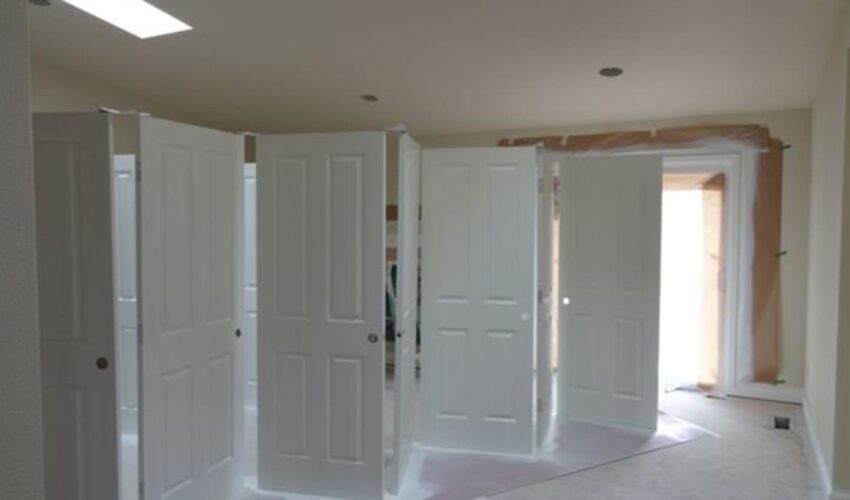Painting Internal Doors With a Sprayer Painting interior doors, particularly six-paneled doors, by hand is extremely difficult and time-consuming without a sprayer. A sprayer, equipped with the right paint and spray tip size, gives you the smoothest finish on doors, without spending hours of mind-numbing work brushing and rolling each coat of paint. Setting up a sprayer and a workspace for spray painting doors takes time, initially, so using a sprayer makes sense if you’re faced with the task of painting multiple doors, but not so much for painting only one. What’s the Best Sprayer for Spray Painting Interior Doors? The best sprayer for spray painting multiple interior doors is an airless sprayer. You can rent them from a paint store, or even buy an inexpensive one from a home improvement store. However, if you need a reliable sprayer for repeated use, buying a professional sprayer is a worthy investment. Airless vs HVLP for Spray Painting DoorsI do most of my spraying, including cabinets and interior doors, with a Graco 495 Ultra Max airless sprayer. This is a contractor-grade sprayer that I’ve used for several years without any issues. I personally wouldn’t buy any other brand. Graco sprayers last if you take good care of them. The advantage of using a larger airless sprayer to paint doors is that these siphon paint directly from a paint can, or bucket, so you won’t have to reload your paint nearly as much as you would using a cup sprayer. A hand-held, airless sprayer, or an HVLP sprayer, are also good choices if you’re only painting two to three doors. These compact sprayers produce far less over-spray, but they also hold far less paint, making them a bad choice for spray painting several doors. You would have to keep stopping to reload your paint, thinning it to the right viscosity each time. You don’t have to thin paint using an airless sprayer. While it’s true that an HVLP sprayer produces a fine finish with less overspray, you can get excellent results too using an airless, equipped with a fine finish tip of the correct size. How to Spray Paint Internal Doors With an Airless SprayerFirst, set up a workspace. (Learn how below.)Prep the doors (see below) and tape off all areas you don’t want to be painted.Position each door properly (instructions below).Decide if you need a primer or not.Spray them, using the technique described below.How to Set Up Your WorkspaceFirst, set up a workspace big enough to accommodate the doors for spraying. What I do is spray doors in a garage, if possible, or I’ll have the customer clear a room in the house. The floors need to be covered with heavy-weight drop cloths, or two layers of painter’s plastic.Nearby walls and windows need to be masked with plastic, as well as the room opening if you’re spraying inside the house. I highly recommend using the 3M hand masker to do your masking. This tool saves a lot of time, trust me.Do You Need to Remove Doors for Spray Painting?I’ve done it both ways, but it’s definitely better to remove the doors and spray them all in one room. You can leave the doors hung and spray them that way, but you’ll have to mask all of the hinges and nearby walls with tape and plastic, which usually ends up taking more time than removing them for spraying.Removing and spraying the doors together keeps the over-spray confined in one room instead of all over the house. When you remove the doors, write a number on the top of each door with a marker so you know which door goes in what room at the end of the job. Stick a piece of tape over the number. http://dublinrenovation.ie/services/painting/ Setting Up Doors for Spray PaintingThe fastest and easiest way to spray paint interior doors is to spray them standing in pairs, vertically, so both sides can be sprayed. To do this, you’ll need to connect each pair of doors at their top edge, using free stir sticks from the paint store, or any piece of scrap wood that’s long enough.Position each pair of doors at a 90-degree angle and drill a stir stick into the top side of the doors to hold them standing up. Connecting the door tops in pairs is easier for one person to do alone, and this method allows all of the doors to be sprayed, both sides, in one spray session.Do Interior Doors Need to be Primed?If you’re spraying pre-primed, or pre-painted, internal doors, a prime coat isn’t necessary. In that case, a light sanding, followed by two coats of durable interior paint, is all that’s needed. Unpainted doors that are stained and lacquered need to be sanded and primed with an oil-based primer.Oak doors involve more prep work before spray painting, mostly to hide the grain. Oak looks horrible when the paint is sprayed over its open grain. The grain should always be filled with at least one coat of grain filler so the deep cracks aren’t visible through the paint. I use Aqua Coat grain filler whenever I’m prepping and spray painting oak.The Best Airless Spray Tip Size for DoorsWhen spraying doors with an airless sprayer, using the appropriate tip size is very important. Using an oversized tip wastes paint and blows too much over-spray everywhere. The key is to fine-tune your application technique, using a tip that throws paint onto doors quickly without making a mess.The best tip to use for spraying interior doors with an airless sprayer is a 310, or a 312 tip. These tips produce a 6-inch spray fan to coat doors quickly with less overlapping than using a smaller tip.

